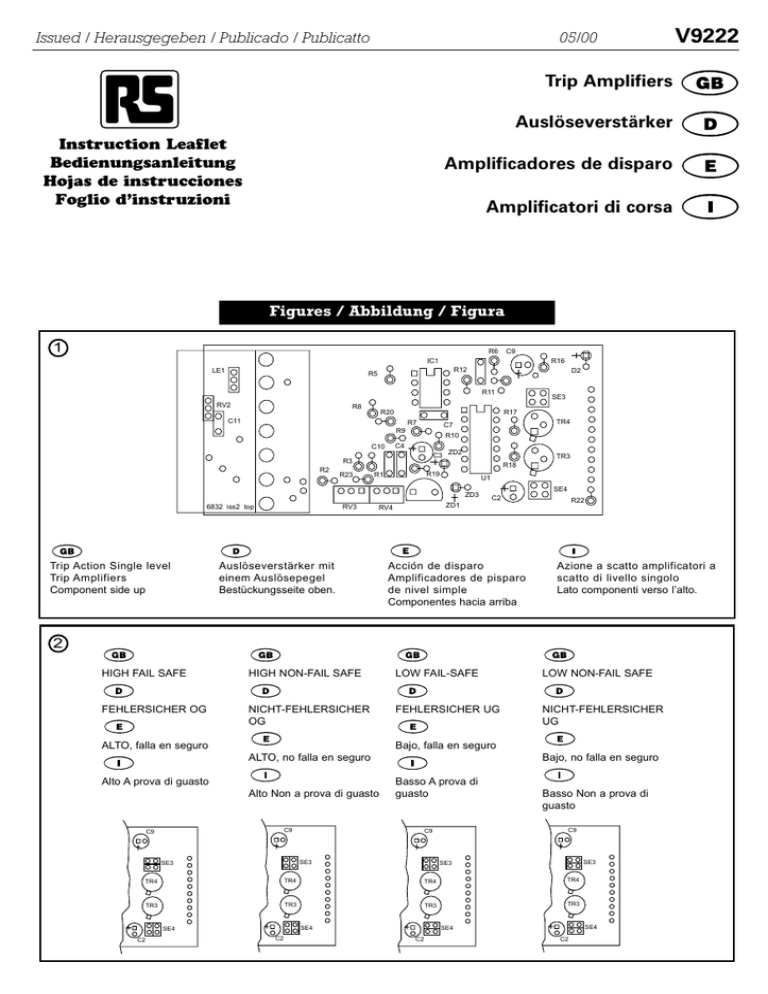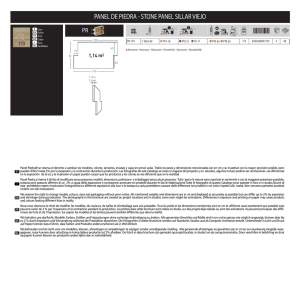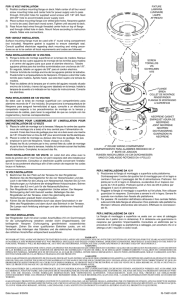Trip Amplifiers Auslöseverstärker Amplificadores de disparo
Anuncio

Issued / Herausgegeben / Publicado / Publicatto 05/00 V9222 Trip Amplifiers Auslöseverstärker Instruction Leaflet Bedienungsanleitung Hojas de instrucciones Foglio d’instruzioni Amplificadores de disparo Amplificatori di corsa Figures / Abbildung / Figura 1 R6 C9 R16 IC1 LE1 R12 R5 D2 R11 RV2 R8 C11 R7 TR4 C7 R10 R9 C4 C10 C3 ZD2 TR3 R3 R2 R23 R18 R19 R1 U1 ZD3 6832 iss2 top Trip Action Single level Trip Amplifiers Component side up RV3 SE3 R17 R20 Auslöseverstärker mit einem Auslösepegel Bestückungsseite oben. SE4 C2 R22 ZD1 RV4 Acción de disparo Amplificadores de pisparo de nivel simple Componentes hacia arriba Azione a scatto amplificatori a scatto di livello singolo Lato componenti verso l’alto. 2 HIGH FAIL SAFE HIGH NON-FAIL SAFE LOW FAIL-SAFE LOW NON-FAIL SAFE FEHLERSICHER OG NICHT-FEHLERSICHER OG FEHLERSICHER UG NICHT-FEHLERSICHER UG ALTO, falla en seguro Bajo, falla en seguro ALTO, no falla en seguro Alto A prova di guasto Alto Non a prova di guasto Bajo, no falla en seguro Basso A prova di guasto C9 C9 C9 C9 SE3 SE3 Basso Non a prova di guasto SE3 SE3 TR4 TR4 TR4 TR4 TR3 TR3 TR3 TR3 SE4 SE4 C2 C2 SE4 SE4 C2 C2 V9222 3 C6 R6 C5 D1 R5 C9 IC1 R12 LE1 RL1 SE3 R11 R8 R16 R13 R4 D2 SE1 U1 R14 RV2 TR2 C8 C11 R7 R20 C7 R10 R9 R17 R18 TR4 TR1 TR3 SE2 C4 R3 R1 C3 ZD2 LE2 R23 R19 6832 iss2 top Dual Level Trip Amplifiers Component side up R15 C10 R2 RV3 Auslöseverstärker mit zwei Auslösepegeln Bestückungsseite oben. ZD3 ZD1 RV4 C1 SE4 C2 Amplificadores de disparo de doble nivel Componentes hacia arriba R22 Amplificatori a scatto a livello duplice Lato componenti verso l’alto. 4 HIGH HIGH FAIL SAFE HIGH LOW FAIL-SAFE LOW LOW FAIL SAFE HIGH HIGH NON F-S HIGH LOW NON F-S LOW LOW NON-F-S FEHLERSICHER OG und OG FEHLERSICHER OG und UG FEHLERSICHER UG und UG NICHTFEHLERSICHER OG und OG NICHTFEHLERSICHER OG und UG NICHT-FEHLERSICHER UG und UG Alto Altto, falla en seguro Alto bajo, falla en seguro Bajo bajo, falla en seguro Alto alto, no falla en seguro Alto bajo, no falla en seguro Alto/alto A prova di guasto Alto/basso A prova di guasto Basso/basso A prova di guasto Alto/alto. Non a prova di guasto Alto/basso. Non a prova di guasto C9 SE3 SE1 SE3 SE1 SE3 C9 SE1 SE3 C9 SE1 SE3 Basso/basso. Non a prova di guasto C9 SE1 SE3 SE1 TR4 TR2 TR4 TR2 TR4 TR2 TR4 TR2 TR4 TR2 TR4 TR2 TR3 TR1 TR3 TR1 TR3 TR1 TR3 TR1 TR3 TR1 TR3 TR1 SE2 C2 SE4 2 C9 C9 Bajo bajo, no falla en seguro SE2 SE2 C2 SE4 C2 SE4 SE2 SE2 C2 SE4 C2 SE4 SE2 C2 SE4 V9222 RS Stock No. Type Input Power Supply 629-465 629-471 629-487 629-493 Single Level Dual Level Single Level Dual Level 4 to 20mA 4 to 20mA 0 to 10V 0 to 10V 115/230Vac ±15% 115/230Vac ±15% 115/230Vac ±15% 115/230ac ±15% Trip Amplifiers are supplied with relays that operate in a specified manner with regard to the analogue input signal. The terminology used, such as HIGH or LOW TRIP and FAIL-SAFE or NON-FAIL SAFE OPERATION, refers to the set-up for the relays. HIGH and LOW TRIP refer to the section of the analogue input signal which represents the alarm condition. HIGH TRIP means that the alarm condition is above the setpoint and LOW TRIP means that the alarm condition is below the setpoint. 1. Apply the correct power supply, 115 volt 50/60 Hz across terminals 13 and 14, or, 230 Volt 50/60 Hz across terminals 12 and 14. 2. Rotate the set-point potentiometers RV1 (DIN120 only) and RV2 to 0% (fully anti-clockwise) 3. Inject a 0% signal 4. Rotate RV4 (the Zero potentiometer) to the point where the trip LEDs LE1 and LE2 (DIN120 only) just change colour. 5. Rotate the set-point potentiometers RV1 (DIN 120 only) and RV2 to 100% (fully clockwise) 6. Set the input to 100% of span 7. Rotate RV3 (the Span Potentiometer) to the point where the trip LEDs LE1 and LE2 (DIN120 only) just change colour 8. Repeat operations 1 to 7 until both points are as close as possible 9. Set the input to 50% of span 10. Check that LE1 changes colour when RV2 is at the 50% point 11. Check that LE2 (DIN120 only) changes colour when RV1 is at the 50% point Having reset the potentiometers, we recommend that the pots are sealed using a suitable sealant. FAIL-SAFE OPERATION means that the relays are normally energised and will de-energise in the alarm condition, i.e. the relays FAIL to the alarm condition in the event of a power failure. Finally replace the instrument in its casing and re-insert the fascia window. NON-FAIL SAFE OPERATION means that the relays are normally deenergised and will energise in the alarm condition. RS Components shall not be liable for any liability or loss of any nature (howsoever caused and whether or not due to RS Components’ negligence) which may result from the use of any information provided in RS technical literature. In all cases the state of the relays is indicated by the RED/GREEN LED which is visable through the front of the instrument. RED= Alarm Condition and GREEN=Normal or Safe condition. The instruments are factory set to: for: 1.Single Level Trip Amplifiers - High Non-Fail Safe 2.Dual Level Trip Amplifiers - High (and) Low Fail-Safe These trip settings can be readily changed by the removal and reinsertion of the jumper links on a series of jumper pads located on one of the printed circuit boards (PCB’s) within the instrument. The instrument comprises two separate PCB’s joined together by a flexible connector strip. In order to remove the PCB’s from the outer case first remove the front panel by inserting a screwdriver under the top or bottom edge and lever out. The terminal block retaining lugs are released by gently easing the sides of the outer casing away from these blocks. They can then be individualy pulled forward, permittingthe two attached PCB’s to be slid out of the case together. Care should be taken when removing the PCB’s from the outer casing. Both PCB’s must be removed at the same time.and handled so that the connector strip is not subjected to the full weight of either PCB. PLEASE ENSURE THAT THE POWER SUPPLY IS SWITCHED OFF PRIOR TO EXTRACTING THE PCB’s. Diagrams overleaf show the location of the jumper pads and the orientation of the links in order to achieve the required relay action. Calibration Each instrument is supplied factory calibrated and no further adjustment should be necessary. If it does become necessary to trim the calibration then please carry out the following procedure: First you will need to remove the instrument from its casing as detailed above. 3 V9222 RS Best-Nr. RS Best-Nr Ty p Eingang 629-465 629-471 629-487 629-493 ein Pegel zwei Pegel ein Pegel zwei Pegel 4 bis 20mA 4 bis 20mA 0 bis 10V 0 bis 10V Betriebsspannung 115/230V AC 115/230V AC 115/230V AC 115/230V AC ±15% ±15% ±15% ±15% Weise arbeiten. Die hier verwendeten Bezeichnungen OG- oder UGAUSLÖSUNG und FEHLERSICHERER oder NICHTFEHLERSICHERER BETRIEB beziehen sich auf die Einstellungen für diese Relais. OG- und UG-AUSLÖSUNG beziehen sich auf den Teil des analogen Eingangssignals, der eine Alarmbedingung darstellt. OG-AUSLÖSUNG bedeutet, daß der Alarm ausgelöst wird, weil der obere Grenzwert überschritten wurde, während bei einer UG-AUSLÖSUNG, dementsprechend der untere Grenzwert unterschritten wurde. FEHLERSICHERER BETRIEB bedeutet, daß die Relais normalerweise angezogen sind und bei einer vorhandenen Alarmbedingung abfallen, das heißt, sie fallen auch bei einem Stromausfall ab und wechseln in den Alarmzustand. NICHT-FEHLERSICHERER BETRIEB bedeutet, daß die Relais normalerweise nicht angezogen sind und erst bei einer vorhandenen Alarmbedingung anziehen. In beiden Fällen wird der jeweilige Schaltzustand der Relais mit einer ROTEN/GRÜNEN LED angezeigt, die durch die Fronttafel des Auslöseverstärkers sichtbar ist. ROT = Alarmbedingung, GRÜN = Normaler oder sicherer Betrieb Ab Werk sind die Geräte in folgender Weise eingestellt: 1. Auslöseverstärker mit einem Auslösepegel – Nicht-fehlersicher OG 2. Auslöseverstärker mit zwei Auslösepegeln – Fehlersicher OG und UG Sie können diese Auslöseeinstellungen jederzeit problemlos ändern, indem Sie die Brückenstecker der entsprechenden Steckbrücken auf einer der Leiterplatten im Gerätgehäuse in die von Ihnen gewünschte Stellung bringen. Das Gerät besitzt zwei voneinander getrennte Leiterplatten, die über einen flexiblen Leiterplattensteckverbinder miteinander verbunden sind. Damit Sie die Leiterplatten aus dem Gerätegehäuse nehmen können, müssen Sie zuerst die Fronttafel entfernen, indem Sie einen Schraubendreher unter den oberen oder unteren Tafelrand ansetzen und die Fronttafel dann vorsichtig herausdrücken. Sie können die Anschlußklemmen dann aus ihren Haltenasen lösen, indem Sie die Seiten des Gerätegehäuses vorsichtig von den Anschlußklemmen weg nach außen drücken. Anschließend können Sie die Anschlußklemmen einzeln nach vorn ziehen und dann die beiden miteinander verbundenen Leiterplatten zusammen nach vorn aus dem Gerätegehäuse schieben. Seien Sie besonders vorsichtig, wenn Sie die Leiterplatten aus dem Gerätegehäuse entfernen. Sie müssen beide Leiterplatten gleichzeitig entfernen und dabei insbesondere darauf achten, daß der flexible Leiterplattensteckverbinder nicht das volle Gewicht einer der beiden Leiterplatten zu tragen hat. SCHALTEN SIE VOR DEM ENTFERNEN DER LEITERPLATTEN UNBEDINGT DIE STROMVERSORGUNG AUS. 4 Den umseitigen Abbildungen können Sie die Lage der Steckbrücken und die erforderliche Stellung der Brückenstecker entnehmen, um das von Ihnen gewünschte Verhalten bei einer Alarmbedingung einzustellen. Kalibrieren Vor der Auslieferung wird jedes Gerät im Werk kalibriert, so daß keine weitere Einstellung notwendig sein sollte. Falls die Kalibrierung des Geräts dennoch einmal abgeglichen werden muß, gehen Sie hierzu wie folgt vor: Zuerst müssen Sie das Gerät so aus dem Gerätegehäuse nehmen, wie es oben beschrieben wurde. Anschließend fahren Sie in folgender Weise fort: 1. Legen Sie die korrekte Betriebsspannung an das Gerät (115V AC bei 50/60Hz zwischen die Klemmen 13 und 14 oder 230V AC bei 50/60Hz zwischen die Klemmen 12 und 14). 2. Drehen Sie die Sollwert-Potentiometer RV1 (nur DIN 120) und RV2 in die Stellung für 0% (bis zum Anschlag nach links). 3. Speisen Sie ein )%-Signal ein. 4. Drehen Sie das Stellpotentiometer RV4 (Nullpunkteinstellung) bis zu dem Punkt, an dem die LED-Auslöseanzeigen LE1 und LE2 (nur DIN 120) die Farbe zu wechseln beginnen. 5. Drehen Sie die Sollwert-Potentiometer RV1 (nur DIN 120) und RV2 in die Stellung für 100% (bis zum Anschlag nach rechts). 6. Legen Sie an den Eingang ein Signal mit 100% des Bereichs an. 7. Drehen Sie das Stellpotentiometer RV3 (Bereichseinstellung) bis zu dem Punkt, an dem die LED-Auslöseanzeigen LE1 und LE2 (nur DIN 120) die Farbe zu wechseln beginnen. 8. Wiederholen Sie die Schritte 1 bis 7 so lange, bis die beiden Sollwerte möglichst nah beieinander liegen. 9. Legen Sie an den Eingang ein Signal mit 50% des Bereichs an. 10. Überprüfen Sie, ob die LED-Auslöseanzeige LE1 die Farbe wechselt, wenn das Sollwert-Potentiometer RV2 in der Stellung für 50% steht. 11. Überprüfen Sie, ob die LED-Auslöseanzeige LE2 (nur DIN 120) die Farbe wechselt, wenn das Sollwert-Potentiometer RV1 in der Stellung für 50% steht. Nachdem Sie die Potentiometer eingestellt haben, sollten Sie die Potentiometer mit einem geeigneten Lack in ihrer Stellung fixieren. Setzen Sie das Gerät wieder in das Gerätegehäuse ein, und befestigen Sie dann die Fronttafel. RS Components haftet nicht für Verbindlichkeiten oder Schäden jedweder Art (ob auf Fahrlässigkeit von RS Components zurückzuführen oder nicht), die sich aus der Nutzung irgendwelcher der in den technischen Veröffentlichungen von RS enthaltenen Informationen ergeben. V9222 Calibración Todos los instrumentos se suministran calibrados en fábrica y no debería ser necesario ningún ajuste adicional. Si lo fuera, lleve a cabo el siguiente procedimiento. Código RS Tipo Entrada 629-465 629-471 629-487 629-493 Nivel simple Nivel doble Nivel simple Nivel doble 4 a 20mA 4 a 20mA 0 a 10V 0 a 10V Fuente de alimentación 115/230Vca 115/230Vca 115/230Vca 115/230Vca ±15% ±15% ±15% ±15% Los amplificadores de disparo se suministran con relés que funcionan de un modo específico en relación con la señal de entrada analógica. La terminología utilizada (como, por ejemplo, DISPARO ALTO o BAJO, FUNCIONAMIENTO A PRUEBA DE FALLO o FUNCIONAMIENTO NO A PRUEBA DE FALLO) se refiere a la preparación de los relés. El DISPARO ALTO o BAJO se refiere a aquella sección de la entrada analógica que representa la situación de alarma. DISPARO ALTO significa que la situación de alarma está por encima del punto de ajuste, y DISPARO BAJO significa que la situación de alarma está por debajo del punto de ajuste. FUNCIONAMIENTO A PRUEBA DE FALLO significa que los relés están normalmente activados y se desactivarán en situación de alarma; es decir, que los relés FALLAN en la situación de alarma al cortarse la corriente. FUNCIONAMIENTO NO A PRUEBA DE FALLO significa que los relés normalmente desactivados, y quedarán conectados en la situación de alarma. En todos los casos, el estado de los relés viene indicado por el LED ROJO/VERDE que queda visible a través del frontal del instrumento. ROJO = situación de alarma. VERDE = situación normal o segura. Los instrumentos vienen ajustados de fábrica en la forma siguiente: para 1. Amplificadores de disparo de nivel simple - alto no a prueba de fallo 2. Amplificadores de disparo de doble nivel - alto (y) bajo a prueba de fallo Estos ajustes de disparo se pueden cambiar con facilidad, retirando y volviendo a colocar los puentes de una serie de soportes de puente situados en una de las tarjetas de circuito impreso (PCBs) que hay en el instrumento. En primer lugar tendrá que extraer el instrumento de su carcasa tal como se explica a continuación. 1. Aplique la alimentación eléctrica correcta, 115 voltios a 50/60 Hz entre los terminales 13 y 14 o 230 V a 50/60 Hz entre los terminales 12 y 14. 2. Haga girar los potenciómetros de punto de ajuste RV1 (sólo DIN 120) y RV2 al 0% (totalmente en el sentido contrario al de las agujas del reloj). 3. Inyecte una señal del )%. 4. Haga girar RV4 (el potenciómetro de Cero) al punto en el que los LED de disparo LE1 y LE2 (sólo DIN 120) cambien de color. 5. Haga girar los potenciómetros de punto de ajuste RV1 (sólo DIN 120) y RV2 al 100% (totalmente en el sentido de las agujas del reloj). 6. Fije la entrada al 100% de la gama. 7. Haga girar RV3 (el potenciómetro de gama) al punto en el que los LED de disparo LE1 y LE2 (sólo DIN 120) cambien de color. 8. Repita las operaciones 1 a 7 hasta que ambos puntos estén lo más cercanos posible. 9. Fije la entrada al 50% de la gama. 10 Compruebe que LE1 cambia de color cuando RV2 está en el punto del 50%. 11. Compruebe que LE2 (sólo DIN 120) cambia de color cuando RV1 está en el punto del 50%. Después de reiniciar los potenciómetros aconsejamos sellar los contenedores con un sellante adecuado. Finalmente, vuelva a colocar el instrumento en su carcasa y vuelva a insertar la ventana frontal. RS Components no será responsable de ningún daño o responsabilidad de cualquier naturaleza (cualquiera que fuese su causa y tanto si hubiese mediado negligencia de RS Componentscomo si no) que pudiese derivar del uso de cualquier información incluida en la documentación técnica de RS. El instrumento lleva dos PCBs independientes, unidas entre sí mediante una banda de conector flexible. Para retirar las PCB de la carcasa exterior hay que quitar primero el panel frontal, introduciendo un destornillador debajo del borde superior o inferior, y después apalancando. Las orejetas que retienen el bloque de terminales se sueltan, separando cuidadosamente los laterales del cuerpo exterior de dichos bloques. Entonces se podrán sacar hacia delante uno a uno, permitiendo que las dos PCB que van unidas se deslicen juntas fuera de la carcasa. Proceda con cuidado al retirar las PCB de la carcasa exterior. Ambas PCB deben retirarse al mismo tiempo, y manejarse de tal manera que la banda conectora no sujete todo el peso de cualquiera de las PCB. ES IMPORTANTE DESCONECTAR LA ACOMETIDA DE CORRIENTE ANTES DE SACAR LAS PCBs. Los esquemas que figuran al dorso muestran el emplazamiento de los soportes de los puentes y la orientación de los enlaces que permitan obtener la acción de relé deseada. 5 V9222 Calibro Ogni strumento viene calibrato in fabbrica e ulteriori regolazioni non dovrebbero essere necessarie. In caso contrario, attenersi alla seguente procedura. Codice RS 629-465 629-471 629-487 629-493 Modello Livello singolo Livello duplice Livello singolo Livello duplice Ingresso da 4 a 20 mA da 4 a 20 mA da 0 a 10 V da 0 a 10 V Alimentazione 115/230Vca ±15% 115/230Vca ±15% 115/230Vca ±15% 115/230Vca ±15% Rimuovere innanzitutto l'apparecchiatura dall'alloggiamento, come illustrato in precedenza. Gli amplificatori a scatto sono forniti con relè che funzionano in una maniera stabilita con riferimento al segnale analogico di ingresso. La terminologia usata, quale SCATTO ALTO o BASSO, FUNZIONAMENTO A PROVA DI GUASTO oppure NON A PROVA DI GUASTO, si riferisce all’impostazione impartita ai relè. SCATTO ALTO E BASSO si riferiscono a quella porzione del segnale di ingresso analogico che rappresenta la condizione di allarme. SCATTO ALTO significa che la condizione di allarme è superiore al punto di impostazione e SCATTO BASSO significa che la condizione di allarme è al di sotto del punto di impostazione. FUNZIONAMENTO A PROVA DI GUASTO significa che i relè sono normalmente eccitati e si diseccitano in condizione di allarme, vale a dire che il relè cede alla condizione di allarme dopo perdita di potenza. FUNZIONAMENTO NON A PROVA DI GUASTO significa che i relè sono normalmente diseccitati e si eccitano in condizione di allarme. In tutti i casi lo stato dei relè è indicato dal LED ROSSO/VERDE che è visibile attraverso il frontale dello strumento. ROSSO = Condizione di allarme e VERDE = condizione normale o di sicurezza. Gli strumenti sono impostati in fabbrica come segue: per 1. Amplificatori a scatto ad un singolo livello - Scatto alto non a prova di guasto 2. Amplificatori a scatto a livello duplice - Scatto alto (e) basso a prova di guasto Queste impostazioni iniziali possono essere facilmente cambiate dalla rimozione e dalla reinserzione di ponticelli su una serie di piazzole da ponticelli poste su una delle schede a circuito stampato contenute nello strumento. Lo strumento comprende due schede a circuito stampato unite da una striscia flessibile di connessione. Per togliere le schede dal contenitore esterno togliere il pannello frontale infilando un cacciavite sotto il bordo superiore od inferiore e facendo leva. Le staffe che trattengono la morsettiera sono liberate allargando delicatamente i lati del contenitore esterno rispetto alle morsettiere stesse. Esse possono essere tirate in avanti singolarmente, consentendo di sfilare dal contenitore le due schede a circuito stampato unite tra loro. Bisogna prestare molta attenzione quando si tolgono le schede circuito stampato dal contenitore esterno. Entrambe le schede circuito stampato devono essere estratte contemporaneamente devono essere maneggiate in modo che la striscia flessibile connessione non venga caricata dall’intero peso delle due schede. a a e di CONTROLLARE CHE L’ALIMENTAZIONE SIA STACCATA PRIMA DI ESTRARRE LE SCHEDE A CIRCUITO STAMPATO. Gli schemi sul retro illustrano la posizione delle piazzole dei ponticelli e l’orientamento dei collegamenti in modo da ottenere la desiderata azione dei relè. 6 1. Applicare la tensione appropriata, 115 volt 50/60 Hz, ai terminali 13 e 14 oppure 230 Volt 50/60 Hz ai terminali 12 e 14. 2. Ruotare i potenziometri RV1 (solo DIN120) e RV2 su 0% (completamente in senso antiorario) 3. Applicare un segnale )% 4. Ruotare RV4 (potenziometro Zero) finché i LED LE1 e LE2 (solo DIN120) cambiano colore. 5. Ruotare i potenziometri RV1 (solo DIN 120) e RV2 su 100% (completamente in senso orario) 6. Impostare l'entrata su 100% 7. Ruotare il potenziometro RV3 finché i LED LE1 e LE2 (solo DIN120) cambiano colore 8. Ripetere le operazioni da 1 a 7 finché entrambi i punti non risultano quanto più vicini possibile 9. Impostare l'entrata su 50% 10. Controllare che LE1 cambi colore quando RV2 è su 50% 11. Controllare che LE2 (solo DIN120) cambi colore quando RV1 è su 50% Una volta reimpostati i potenziometri, si consiglia di bloccarli con un sigillante appropriato. Infine, inserire nuovamente l'apparecchiatura nell'alloggiamento e installare la finestra di fascia. La RS Components non si assume alcuna responsabilità in merito a perdite di qualsiasi natura (di qualunque causa e indipendentemente dal fatto che siano dovute alla negligenza della RS Components), che possono risultare dall’uso delle informazioni fornite nella documentazione tecnica.







